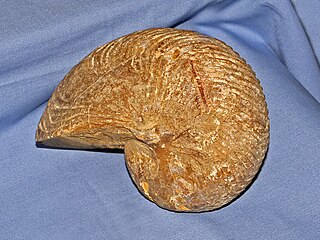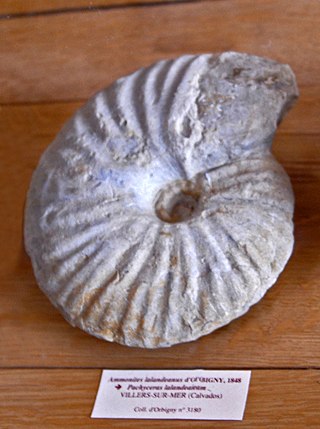
Anagaudryceras is an extinct genus of ammonite from the later Cretaceous belonging to the Ammonoidea family Gaudryceratidae. Anagaudryceras has a moderately involute shell with a deep umbilicus and strongly ribbed outer whorl. Ribs are thick and rounded and cross over the venter uninterrupted.
Balvia is an ammonoid cephalopod genus from the Upper Devonian belonging to the goniatitid family Prionoceratidae.
Yinoceras is a genus of middle Permian goniatitid ammonite, the type genus for the subfamily Yinoceratinae of the family Pseudohaloritidae.
Dimeroceratidae is one of three families in the Dimeroceratoidea, a goniatid superfamily included in the Ammonoidea; extinct shelled cephalopods with adorally convex septa and usually narrow ventro-marginal siphuncles.
The Posttornoceratidae are Late Devonian goniatites (Ammonoidea) included in the superfamily Tornoceratoidea. The family, Posttornoceratidae, named by Bogoslovsky in 1962, is based on the genus Posttornoceras, named by Wedekind in 1910, originally included in the Tornoceratidae.
Thalassoceratoidea, formerly Thalassocerataceae, is a superfamily of Late Paleozoic ammonites characterized by their thick-discoidal to subglobular, involute shells with narrow or closed umbilici and biconvex growth striae with ventral sinuses. The ventral lobe of the suture, which straddles the outer rim, is wide, and bifid, with a tall median saddle.
Texoceras is an extinct ammonoid genus in the monotypic goniatitid subfamily Texoceratinae, included in the family Adrianitidae. These were shelled cephalopods more closely related to squids, belemnites, octopuses, and cuttlefish than to nautiloids from which they are derived.

Cyclolobidae: Goniatitid Ammonoidea belonging to the Cycloloboidea with thickly discoidal to subglobular shells with a small but open umbilicus and ammonitic sutures with numerous lobes that have subparallel sides.
Bisatoceratidae is a family of Late Paleozoic ammonites now included in the Thalassoceratoidea characterized by thick-discoidal to subglobular, involute shells in which lobes are simple. Some forms have spiral ornamentation.
Hebetoxyites is a genus of ammonoid cephalopod from the middle part of the Bajocian stage, middle Jurassic, included in the Strigoceratidae, Haploceratoidea. The shell is oxyconic, with a sharp rim but no keel, and involute, with the inner whorls hidden. The umbilicus is very small. Sides have a spiral ridge but are not striate.
Zetoceras is an extinct ammonoid cephalopod genus from the suborder Phylloceratina that lived during the Early and Middle Jurassic in what is now Europe, and is included in the (family) Phylloceratidae.

The Cymatoceratidae is a family of Mesozoic and early Cenozoic nautiloid cephalopods and the most abundant of their kind in the Cretaceous. They are characterized by ribbed, generally involute shells of varied forms - coiled such that the outer whorl envelops the previous one, as with Nautilus, and sutures that are variably sinuous.
Ptychitoidea, formerly Ptychitacheae, is a superfamily of typically involute, subglobular to discoidal Ceratitida in which the shell is smooth with lateral folds or striations, inner whorls are globose, and the suture is commonly ammonitic. Their range is Middle_ and Upper Triassic.
Liroceras is a genus of nautiloid cephalopod. It is the type genus of the clydonautiliacean family, Liroceratidae, and is characterized by a rapidly expanding, subglobular, nautiliconic shell with a reniform whorl section, small umbilicus, essentially straight sutures, and a siphuncle with a variable but not marginal position.

Macrocephalites is a genus of the stephanoceratoid ammonite family Macrocephalitidae, diagnostic of the Callovian stage of the Middle Jurassic. Three subgenera, Dolikephalites, Kamptokephalites, and Pleurocephalites are recognized in addition to Macrocephalites itself, with Indocephalites tentatively included as the fourth.

Cleoniceras is a rather involute, high-whorled hoplitid from the Lower to basal Middle Albian of Europe, Madagascar, and the Transcaspian region. The shell has a generally small umbilicus, arched to acute venter, and typically at some growth stage, falcoid ribs that spring in pairs from umbilical tubercles, usually disappearing on the outer whorls.
Pachylyroceras is a large, generally subglobular, Upper Mississippian gonitite and included in the cephalopod subclass Ammonoidea.

Mantelliceras is an extinct ammonoid cephalopod genus belonging to the family Acanthoceratidae and type for the subfamily Mantelliceratinae, that lived from the Late Albian to the late Cenomanian stage of the Late Cretaceous.
Phaedrysmocheilus is a genus of Early Triassic Tainoceratids from Siberia. The shell is a rapidly expanding, moderately involute nautilicone; smooth in the adult stage but laterally ribbed in the juvenile stage. Volutions are convex laterally, arched ventrally, embraced dorsally. Whorl sections change during development from being slightly depressed, early, to slightly compressed later, changing from being relatively wide to relatively high. The umbilicus is deep and funnel shaped. Sutures are slightly sinuous.

Pachyceras is a genus of perisphinctoid ammonites from the Middle Jurassic, upper Callovian stage, and is the type genus for the family Pachyceratidae. The shell is involute, subglobular, with a deep umbilicus and flattened flanks that slope toward a more narrowly rounded venter, and covered by low, widely spaced ribs.







